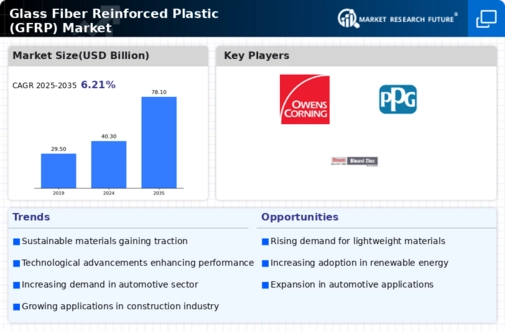Glass Fiber Reinforced Plastic Gfrp Size
Glass Fiber Reinforced Plastic GFRP Market Growth Projections and Opportunities
The market factors influencing the Glass Fiber Reinforced Plastic (GFRP) industry are diverse and dynamic, impacting various aspects of production, demand, and pricing. One of the key factors driving the growth of the GFRP market is its widespread application across multiple industries. GFRP offers numerous advantages over traditional materials like steel or wood, including high strength-to-weight ratio, corrosion resistance, and design flexibility. As a result, industries such as automotive, construction, aerospace, and marine have increasingly adopted GFRP composites in their products and structures, thereby fueling market expansion.
Glass Fibre Reinforced Plastic Market shows an astonishing glass fiber reinforced plastic market growth with a remarkable CAGR during the glass fiber reinforced market forecast period. These glass fiber reinforced plastics are made up of silica-based raw materials which are made up of metal oxides and are made from different formulations which are highly helpful.
Technological advancements also play a significant role in shaping the GFRP market. Continuous innovation in manufacturing processes, such as resin infusion, pultrusion, and automated lay-up techniques, has led to improved product quality, reduced production costs, and enhanced scalability. These advancements have made GFRP more accessible to a wider range of applications, driving further demand growth.
Moreover, increasing environmental concerns and regulations regarding carbon emissions and energy efficiency have propelled the adoption of GFRP materials. As a lightweight and durable alternative, GFRP helps reduce fuel consumption in transportation vehicles, lowers energy usage in buildings, and minimizes environmental impact throughout its lifecycle. This sustainability aspect has resonated with consumers and businesses alike, driving demand for GFRP products.
Market dynamics such as supply chain disruptions, raw material availability, and price volatility also impact the GFRP market. Fluctuations in the prices of key raw materials like glass fibers, resins, and additives can affect production costs and ultimately influence product pricing. Additionally, geopolitical factors, trade policies, and currency fluctuations can introduce uncertainties in the market, affecting global supply and demand dynamics.
Consumer preferences and industry trends also influence the GFRP market. As more consumers prioritize eco-friendly and sustainable products, manufacturers are increasingly focusing on developing GFRP solutions that meet these criteria. This has led to the emergence of bio-based resins, recycled fibers, and other environmentally friendly alternatives within the GFRP industry.
Furthermore, regulatory standards and certifications play a crucial role in shaping the GFRP market landscape. Compliance with international quality standards, such as ISO certifications and ASTM standards, is essential for manufacturers to gain market acceptance and access global supply chains. Additionally, industry-specific regulations related to safety, performance, and environmental impact govern the use of GFRP materials in various applications, influencing market dynamics.
Competitive factors such as market concentration, industry alliances, and technological differentiation also impact the GFRP market. As the industry continues to grow, established players are investing in research and development to maintain their competitive edge and expand their market share. Moreover, strategic partnerships, mergers, and acquisitions enable companies to access new markets, diversify product portfolios, and strengthen their competitive position in the GFRP industry.








Leave a Comment